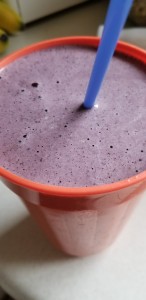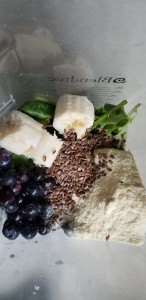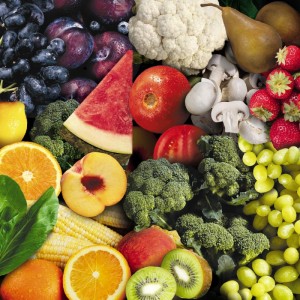
Posted by: Samantha in
Nutrition on November 17th, 2017


Do you know how much calories and sugar are in that protein drink or green smoothie you are consuming? Well, I was not exactly sure either but had a guestimate. Yesterday I put together all the numbers for calories, fat, carbohydrates (CHO), sugar, fat and fiber for my daily protein shake. To my surprise my CHOs and protein content were about even, with CHOs slightly exceeding protein. Bonus is that the sugar content is not too bad and comes almost all from the fruit of a medium to lower glycemic variety (won’t spike insulin). The surprise was the amount of fiber and that it came in under 300 calories. Here are my ingredients and the results:
½ c. water
½ c. Unsweetened Almond Milk
1 c. Kale
½ Frozen Organic Blueberries (highest in anti-oxidants)
½ Banana (medium)
1 TBSP Flax Seeds (7x more lignans by weight than sesame seeds but must be ground to be of benefit)
1 heaping scoop vanilla Protein powder (whey/casein blend)
1 ¼ c. Ice cubes (to give thickness)
Calories: 289.5
Fat: 5g
CHO: 35g
Sugar: 16g
Fiber: 5.5g
Protein: 29g
Why did I do this? I drink this almost every single day after the gym. There are a lot of places like Whole foods, Trader Joes, and sometimes your gym that pedal green, fruit and/or protein smoothies. You want to know how many calories you’re getting and how much sugar because this could be the culprit as to why you are struggling with those few extra pounds or maybe getting rid of that stubborn mid-section. I have been saying this for almost three decades now, it’s not the fat that is killing us, it is the sugar.
Yours in health,
Samantha L. Madsen, MS, CSCS
“Train Smart. Eat Healthy. Rest Well. Supplement Wisely.”
Posted by: Samantha in
Nutrition on September 14th, 2016

I was leaving my girlfriend’s house having just picked up something and she sent me off with a sandwich bag of pear and cherry tomatoes from a friend’s garden. By the time I arrived home the bag only had a few remaining tomatoes—I’d eaten most of them during the drive! Home grown tomatoes, yum! Late summer early fall tomatoes come into season and if you grow your own or are fortunate enough to have family and friends that grow them and share them with you oh what a delicious treat! It made me ponder on the wonderful goodness of this fruit! They come in so many different shapes, sizes and varieties! There are the snack size tomatoes like cherry and pear sizes. There are tomatoes that are great for cooking like roma and plum tomatoes. There’s the beefsteak and celebrity tomatoes that work lovely on sandwiches! There are literally hundreds of varieties! They come in different colors too, ranging from green, yellow to orange to deep red and even a dark purple color. They’re also low in calories—about 32 calories in a cup of chopped tomatoes—and a very low glycemic index number to boot.
Besides being utterly delicious tomatoes are good for you! They are one of the best sources of lycopene you can find! Lycopene is a phytochemical and part of the carotenoid family. It’s a powerful antioxidant that may protect cells from damage. There’s a great deal of research interest on Lycopene’s effect, if any, on preventing cancer. Early research has demonstrated Lycopene’s ability to reduce prostate tumors. Other research with Lycopene is in the areas of bone health in slowing down osteoporosis, cataracts and macular degeneration because of Lycopene’s natural UV protection, heart disease, and atherosclerosis (hardening of the arteries). It’s Lycopene’s strong antioxidant properties that make it such a great interest in research of disease.
Interestingly, processing tomatoes with heat (during canning, making paste, or spaghetti sauce) does not adversely affect Lycopene. In fact, it makes the Lycopene even more readily absorbed. So, slice them, dice them, chop them in a salad or put them on your sandwich! Cook them, can them or sauce them! I just finished eating a whole celebrity one over the sink! Hmmm….tomato love!
Yours in health,
Samantha L. Madsen, MS, CSCS
“Train Smart, Eat Healthy, Sleep Well, Supplement Wisely”

Are you one of the millions of folks that made a New Year’s resolution? We’re into February, have you stuck with it? If not, why? More importantly, does it matter to you? It’s important to analyze this. It’s estimated that 45 percent of American’s make New Year’s resolutions with about 66 percent of those being fitness goals. By the time February rolls around most resolvers have abandoned their New Year’s resolution. Top reasons include being too busy or not being committed to their goals in the first place. Is this you?
Setting goals and being able to achieve them is a learned skill. You don’t come out of the womb armed with goal setting abilities. To be successful in achieving goals there’s certain things you need to want or put in place. Number one, you have to have the desire for your defined goal. You have to want it! If you’re simply joining in what everyone else is saying because it sounds good and you need to lose weight it’s not going to be effective. Every goal requires work, energy, and focus therefore you’ve got to want it enough to be able to concentrate your efforts in that direction.
Saying I want to lose weight or I’m going to begin an exercise program is too general. You have to be specific about your goals. They need to be clearly defined by not only what it is you want to do but how long it’s going to take you to achieve them. In example, losing 30 pounds over a 16 week period offers some detail. This forges a sort of concreteness to your goal as you clearly defined exactly what it is you want to do and over what time period. Beginning an exercise program you would set yourself up for success by defining the number of times per week you plan on exercising, the duration of that exercise, and the activity of the exercise. And don’t be over zealous on this one! A common error! Telling yourself you’re going to go to the gym six days a week when you haven’t been to the gym in years is setting yourself up for failure. Be realistic.
Now that you’ve clearly defined and specified what your goals are you need to share this with someone. This gives ownership to what you’re trying to accomplish and it also provides a confident to share in your successes. I also strongly urge writing down the specifics of your goals and keep this visible; someplace you see it every day. Sometimes we just need to have it in our face as a reminder of what we want to accomplish.
Now you need to define what this pathway of success is going to look like, how you’re going to get there. This can be a little tougher as it requires specificity on how and what you’re going to do to accomplish your goal. If your goal is to lose 30 pounds over 16 weeks then you need to look at your current eating habits and make the necessary adjustments to facilitate weight loss or hire a nutritionist. This is a critical component for success because this is about clarity in the details and needs to be recorded for visualization. If you work long hours and your goal is to go to the gym to lift weights and do cardio for 60 minutes three times per week you need to decide when and where you’re going to carve out the time to do so and lock those dates in. Clarity.
Now once the specifics of your goals are clearly defined you simply go to work. They say variety is the spice of life and so is true for consistently maintaining an exercise regime or long term food goals. Having a plan makes all the difference in leading to your success. The military has a saying, “Fail to plan, plan to fail.” Pretty straight forward and right on the nose!
Within the confines of your over-all goal, define moments of achievement. In the weight loss goal for example, when you lose those first ten pounds celebrate your win! But not with food! Reward yourself with something outside of the food arena, like a new blouse or pair of shoes, or a massage or facial. Allowing yourself to enjoy wins along the way to your goal not only provides encouragement for what you’ve accomplished but it also helps re-train your brain about what those rewards should look like. You’ll find enlisting this behavior will transfer to other parts of your life as well.
We all have set backs. But what’s key is not allowing a bad day define you or your goal so don’t beat yourself up over a moment in time. It’s just that, a moment in time. There’s later in the day or tomorrow to regroup. Having this mind set is a powerful aid. Ever see a gymnast fall off the beam and then get back up and finish her routine without additional errors? This is the power of that mindset. It’s where you focus your energy and your time. Not in the fall which just cost half a point but in a flawless effort for the remainder of the routine. You have to let those bad moments roll off your shoulder and look optimistically forward to your next success.
There’s no time like the present now go out and get it done!
Yours in health,
Samantha L. Madsen, MS, CSCS
“Train Smart, Eat Right, Rest Well, Supplement Wisely”
Posted by: Samantha in
Nutrition on June 6th, 2013

Consumption of red and processed meat has been associated with colorectal cancer in many studies. Only a few studies have examined risk in relation to long-term meat intake or the association of meat with rectal cancer. The purpose of this study was to examine the relationship between recent and long-term meat consumption and the risk of colon and rectal cancer.
The subjects in this study consisted of 148,610 adults aged 50 to 74 years from 21 states with population-based cancer registries. The subjects provided information on meat consumption in 1982 and again in 1992 when they were enrolled in the Cancer Prevention Study II (CPS II) Nutrition Cohort. Subjects were followed from 1992 through 2001 to determine the incidence of colorectal cancers.
Subjects with the highest intakes of red and processed meat in both 1982 and 1992 had the highest incidence of colorectal cancer. Long-term consumption of poultry and fish was inversely associated with risk of colorectal cancer.
The results of this study demonstrate the value of examining long-term meat consumption in assessing cancer risk.
Reference
Chao, Ann. et al. Meat Consumption and Risk of Colorectal Cancer. JAMA. 2005;293:172-182.
Posted by: Samantha in
Nutrition on June 6th, 2013
Certain types of carbohydrates may be good for the heart, according to a new analysis of data from the Women’s Health Study conducted by the Harvard School of Public Health. The federally funded Women’s Health Study is a 10-year randomized trial testing the effects of aspirin and vitamin E in reducing cardiovascular risk in approximately 40,000 women.
Women who ate high-fiber diets rich in fruits, vegetables and whole grains were found to have lower levels of C-reactive protein, a substance in the blood that has been linked to coronary heart disease, the study found.
C-reactive protein plays key role
Most people recognize high cholesterol as a leading cause of heart disease, but new data suggests that testing levels of the C-reactive protein, produced by the liver, is equally important in predicting coronary problems as well as Type 2, or adult onset, diabetes.
High CRP levels in the blood indicate a low-grade inflammation in the body, a condition that is believed to play a role in heart attacks. Inflammation develops when our bodies fight infection or injury and is thought to contribute to or even cause atherosclerosis, or build-up of fatty deposits in the arteries, according to the American Heart Association.
Earlier research from the Women’s Health Study found that women with high levels of inflammation had a greater risk of heart attack or stroke. In the carbohydrate trial, Harvard researchers drew blood from 15,000 women and quizzed them about their diet habits, dividing participants into groups based on their total fiber consumption and glycemic index?the measure of how quickly carbs are absorbed into the body.
‘Carbs are not all created equal’
The researchers found that the CRP levels of women whose diets consisted primarily of refined grains were 10 percent higher than women who consumed a lot of good carbs such as fiber-rich whole grains, fruits and vegetables.
“Carbohydrates have gotten such bad press in the last couple of years, but clearly carbs are not all created equal,” says Emily Levitan, lead researcher of the Harvard carbohydrate study. vThe women who ate foods with the most soluble fiber like oats and oat bran, dried beans, flax seeds, oranges and apples had less inflammation in their body.
“What it means is women should switch to whole grains, start eating brown rice instead of white, eat whole grain breads and whole grain pasta, and also increase their intake of fruits and vegetables, other than potatoes,” says Levitan.
Other studies have linked good carbs with lower weight, but the Harvard study is the largest to show that whole grains can reduce inflammation in the body.
Bad carbs like white bread or refined pastas were linked with increased blood inflammation, which could lead to heart disease later on, Levitan says. Once shunned as the starchy, hunger-causing enemy of lean dieters, high-quality carbs are now major factors in the government’s diet guidelines. But bad carbs like candy bars or processed white bread are still no-nos when it comes to weight control and nutrition. Those sugar-rush carbs are quickly turned into glucose by the body and end up causing you to feel hungry again sooner.
Posted by: Samantha in
Nutrition on June 6th, 2013
Cantaloupe: A quarter of a delicious melon supplies almost as much vitamin A and C as most people need in an entire day.
Sweet Potatoes: A nutritional All-Star, one of the best vegetables you can eat. They are loaded with carotenoids, vitamin C, potassium, and fiber. Mix in unsweetened applesauce or crushed pineapple for extra moisture and sweetness.
Organic Fat-free (Skim) Milk: Excellent source of calcium, vitamins, and protein, with little or no artery-clogging fat and cholesterol.
Blueberries: They are rich in fiber, vitamin C, and antioxidants. In fact, blueberries rate as the most antioxidant food you can consume! So eat up!
Oranges: Great-tasting and rich in vitamin C, folic acid, and fiber.
Broccoli: Lots of vitamin C, carotenoids, and folic acid.
Whole-Grain Bread: It is higher in fiber and has about a dozen vitamins and minerals than enriched white bread or enriched wheat bread.
Watermelon: Excellent source of vitamin C and carotenoids and it tastes great! Perfect for a snack, dessert, or picnics.
Beans: Inexpensive, low in fat, and rich in protein, iron, folic acid, and fiber. Choose garbanzo, pinto, black, navy, kidney, or lentils. Eat them as a side dish or snack, in a tortilla with salsa, or in soup or salad.
Spinach or Kale: Loaded with vitamin C, carotenoids, calcium, and fiber. Steam them and eat them.








